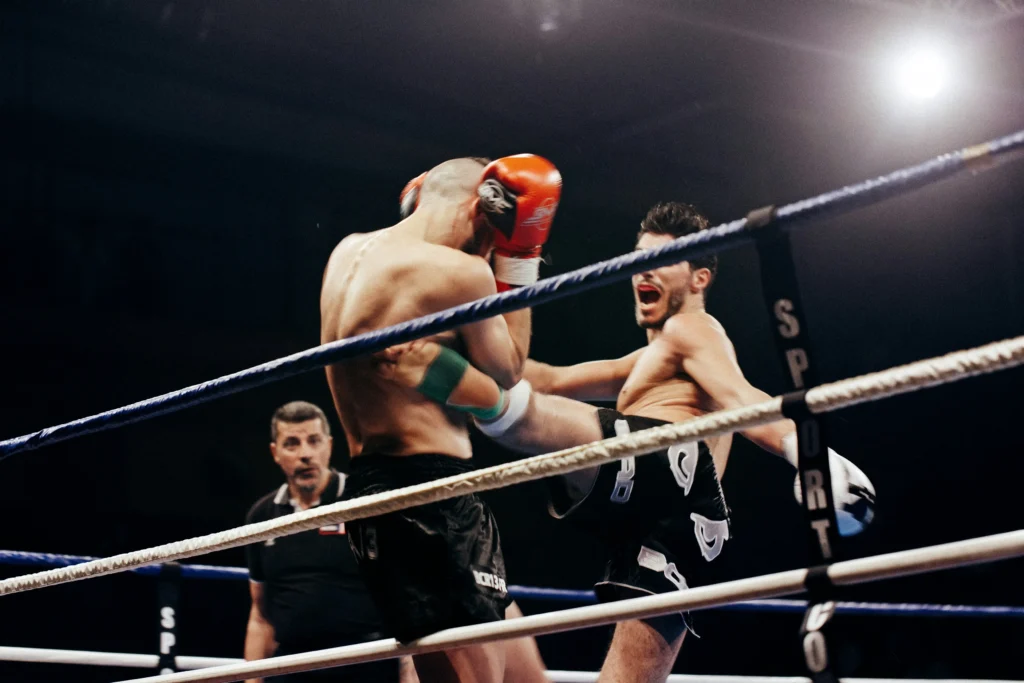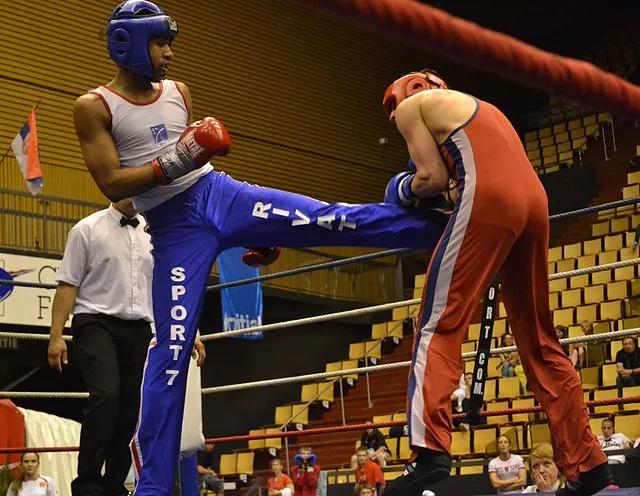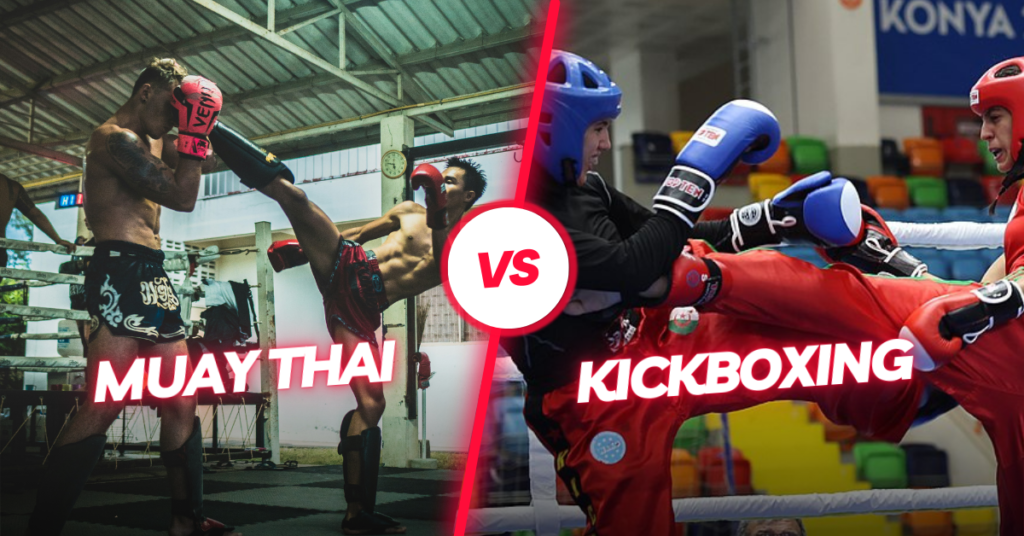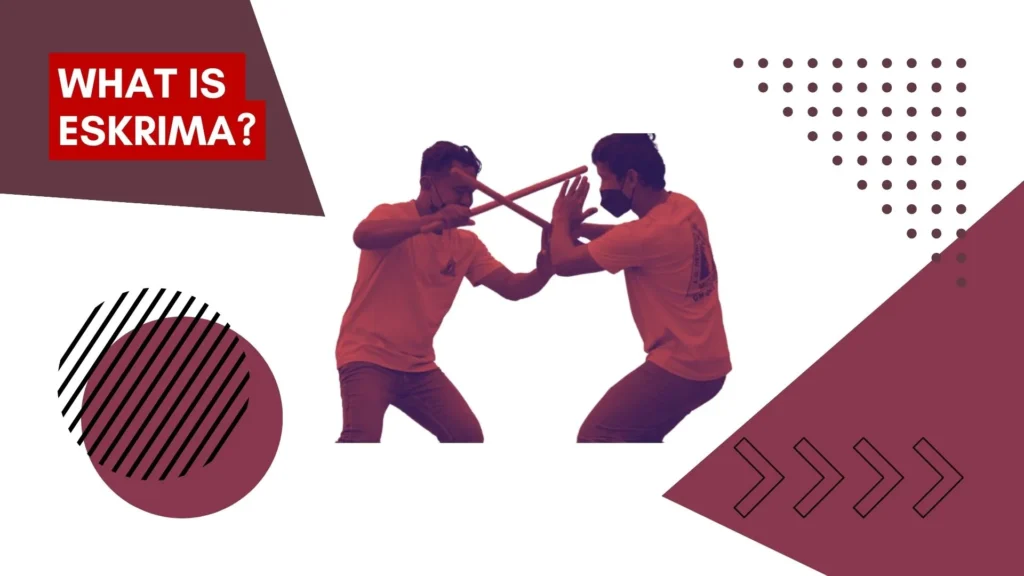When it comes to combat sports, Muay Thai and Kickboxing are often regarded as fierce and powerful martial arts. But have you ever wondered how they differ from each other? While they may share some similarities, Muay Thai and Kickboxing have unique characteristics that set them apart. So, what are the key differences between these two striking sports? All of your questions will be answered in this article “Muay Thai vs Kickboxing”.
Unlike Kickboxing, Muay Thai is known as the “art of 8 limbs.” But what does that mean? And how does it affect the fighting style? Discover the intriguing secrets behind Muay Thai’s striking techniques and understand why it’s considered a comprehensive combat system.
Curious about the origins of both martial arts? Dive into the rich history of Muay Thai and Kickboxing. Uncover how Muay Thai evolved from ancient military combat training in Thailand, while Kickboxing emerged as a blend of karate and full-contact boxing in Japan.
Is it all about punches and kicks? Not quite! Explore the fascinating striking systems and techniques employed in Muay Thai and Kickboxing. Learn about the 8-point striking system of Muay Thai, which incorporates knee strikes, elbow strikes, and upper body grappling. Then, explore the rapid-fire kicks and punches that characterize Kickboxing.
But it doesn’t stop there. Movement and stance play a crucial role in these martial arts. Discover the different footwork and stances used by Muay Thai fighters and Kickboxers. From a measured and even pace to bouncing and circling, understand how these variations contribute to the distinct styles of Muay Thai and Kickboxing.
So, if you’ve ever wondered about the differences between Muay Thai and Kickboxing, get ready to dive deep into the world of striking arts. It’s time to unveil the unique attributes and decide which path suits your combat style.
Table of Contents
Key Takeaways
- Muay Thai and Kickboxing have distinct differences despite their similar appearances.
- Muay Thai originated in Thailand and utilizes an 8-point striking system, including knee and elbow strikes.
- Kickboxing is a hybrid martial art that combines elements of karate, boxing, and Muay Thai to form a 4-point striking system.
- Understanding the history, striking systems, techniques, and movement in Muay Thai and Kickboxing can help you choose the martial art that aligns with your preferred combat style.
- Both Muay Thai and Kickboxing offer excellent workout routines and mental health benefits.
History of Muay Thai and Kickboxing
Understanding the history of Muay Thai and kickboxing provides valuable insights into the development and evolution of these martial arts.
Origins of Muay Thai
With its roots in ancient Thailand, Muay Thai has a rich history that dates back hundreds of years. Originating from the unarmed combat techniques used by Thai soldiers, Muay Thai was practiced as a form of self-defense and military training. Over time, it transitioned into a competitive sport, incorporating various strikes and techniques.
During World War I, Muay Thai gained popularity in the western hemisphere as Thai fighters showcased their skills to foreign soldiers. As the sport expanded internationally, it began to incorporate some Western boxing practices, such as padded gloves and timed rounds within a ring.
The Rise of Kickboxing
Kickboxing, on the other hand, is a relatively modern martial art that emerged in Japan during the 1970s. It was developed as a fusion of karate and full-contact boxing, with the aim of creating a dynamic and versatile fighting style.
Kickboxing quickly gained popularity around the world, with various styles and organizations emerging to further refine the sport. One notable example is K-1 kickboxing, which became globally recognized for its high-profile tournaments and top-level fighters.
In the Netherlands, Dutch Kickboxing emerged as a uniquely aggressive and high-impact style. It emphasizes high-volume punches, forward pressure, and hard low kicks as its core components.
The history of Muay Thai and kickboxing showcases the cultural significance and global reach of these combat sports. Understanding their origins provides a deeper appreciation for the techniques and traditions that still shape these martial arts today.
| Martial Art | Origins | Key Developments |
|---|---|---|
| Muay Thai | Ancient Thailand | Adoption of Western boxing practices during WWI |
| Kickboxing | Japan, 1970s | Evolution into various styles, including K-1 and Dutch Kickboxing |
Striking Systems and Techniques in Muay Thai and Kickboxing
One of the key differences between Muay Thai and Kickboxing is their striking systems and techniques.
Muay Thai utilizes an 8-point striking system that includes punches, kicks, elbow strikes, and knee strikes. This allows for a more diverse range of attacks and combinations. The use of knee strikes and elbow strikes in Muay Thai sets it apart from Kickboxing and gives practitioners additional tools for close-range combat. By incorporating these techniques, Muay Thai fighters can effectively attack from various angles, providing them with a strategic advantage over their opponents.
Kickboxing, on the other hand, follows a 4-point striking system with punches and kicks. The focus in Kickboxing is on high-volume strikes, often executed with speed and precision. Rapid-fire punches and kicks allow Kickboxers to overwhelm their opponents and maintain a relentless attack. The speed and agility of Kickboxing techniques make it a formidable martial art in its own right.
Let’s take a closer look at the techniques used in each martial art:
Muay Thai Techniques:
- Roundhouse kick: A powerful kick executed by swinging the leg in a circular motion, striking the opponent with the shin. This technique allows Muay Thai fighters to deliver devastating kicks with great force.
- Clinch: Muay Thai incorporates a unique clinching technique, where fighters engage in close-quarter combat, using their hands to control their opponent’s neck or arms. This technique enables Muay Thai practitioners to deliver knee strikes and execute sweeps or throws.
- Elbow strike: Muay Thai is renowned for its devastating elbow strikes, which can cause substantial damage to the opponent. These strikes can be executed from various angles and are often used in close-range combat.

Kickboxing Techniques:
- Jab: A quick and straight punch thrown with the lead hand. The jab is used to set up other combinations, maintain distance, or establish control in the ring.
- Hook: A horizontal punch delivered with a bent arm, aiming to strike the opponent’s head or body from the side. The hook is known for its power and the ability to generate knockouts.
- Round kick: Similar to the Muay Thai roundhouse kick, the round kick in Kickboxing focuses on delivering powerful kicks using the shin or instep. It is a versatile and effective technique for both offensive and defensive maneuvers.

By understanding the striking systems and techniques in Muay Thai and Kickboxing, practitioners can make informed decisions about which martial art to pursue based on their preferred style of combat. Whether it’s the diverse range of attacks and combinations in Muay Thai or the speed and precision of Kickboxing, both martial arts offer unique approaches to striking and self-defense.
Movement and Stance in Muay Thai and Kickboxing
In the world of martial arts, movement and stance play a crucial role in the effectiveness of combat. Muay Thai and Kickboxing, two popular disciplines, have distinct approaches to movement and stance, which contribute to their unique styles. Understanding the differences in footwork and positioning is essential for practitioners seeking to master these arts.
Muay Thai Footwork: Muay Thai fighters typically move with a measured and balanced pace. They employ a footwork technique known as the Yang Sam Khum or the “three step march.” With this technique, the feet remain flat on the ground, ensuring stability and enabling quick direction changes. Muay Thai footwork emphasizes maintaining a centered position, allowing fighters to maintain control and execute strikes with precision.
Kickboxing Footwork: Kickboxers, on the other hand, embrace a more dynamic and agile style of movement. They utilize bouncing and circling motions to create angles and set up attacks. Footwork in Kickboxing is designed to enhance mobility and create openings in the opponent’s defense. By constantly moving and shifting positions, kickboxers can surprise their opponents with swift strikes from unexpected angles.
The difference in footwork between Muay Thai and Kickboxing influences the tactical approaches of each martial art. Muay Thai fighters focus on maintaining a solid base, enabling them to deliver powerful strikes while remaining grounded. In contrast, kickboxers use their footwork to create openings and capitalize on their speed and agility.
Stance
The stance adopted by practitioners also varies between Muay Thai and Kickboxing. In Muay Thai, fighters stand with their feet flat on the ground, ensuring a stable base to generate power in their strikes. This stance allows them to utilize their entire body for strikes, and their hands are positioned at the temples, ready to block incoming attacks. The flat-footed stance in Muay Thai emphasizes a strong connection to the ground, providing a solid foundation for offensive and defensive moves.
On the other hand, kickboxers adopt a bladed stance, with one foot positioned significantly ahead of the other. This stance creates a narrower profile, making it harder for opponents to land strikes. The torso is turned sideways, minimizing the target area while allowing kickboxers to generate maximal power and speed in their strikes. The bladed stance in Kickboxing enables fighters to deliver lightning-fast combinations and evade incoming attacks efficiently.
Overall, the contrasting movement styles and stances in Muay Thai and Kickboxing contribute to their unique identities. Muay Thai emphasizes balance, stability, and powerful strikes grounded by flat-footed footwork and a square stance. Meanwhile, Kickboxing focuses on agility, footwork to cut angles, and rapid-fire combinations facilitated by a bladed stance.
Conclusion
Muay Thai and Kickboxing are two distinct martial arts that offer unique benefits and combat styles. Muay Thai, with its emphasis on a wide range of strikes and techniques, including knee and elbow strikes, provides practitioners with a comprehensive combat system. Kickboxing, on the other hand, focuses on high-volume strikes and rapid combinations, creating an exciting and fast-paced fighting style.
Both Muay Thai and Kickboxing offer excellent workouts that help improve physical fitness, endurance, and strength. Engaging in these martial arts also provides mental health benefits such as stress relief, increased self-confidence, and improved focus.
When deciding between Muay Thai and Kickboxing, it ultimately comes down to personal preference and desired combat style. Individuals should consider their goals and preferences in terms of striking techniques and the overall pace of the sport. We recommend trying out both arts to determine which resonates the most with you.
FAQ
What are the key differences between Muay Thai and Kickboxing?
Muay Thai incorporates knee strikes, elbow strikes, and upper body grappling, making it an 8-point striking system. Kickboxing follows a 4-point striking system with punches and kicks.
Kickboxing for self-defense?
Kickboxing is effective for self-defense, teaching striking techniques with hands and feet, enhancing fitness, coordination, and confidence.
Muay Thai for weight loss?
Yes, Muay Thai aids weight loss through intense cardio workouts, calorie burning, and muscle toning, especially when combined with weightlifting.
Muay Thai training frequency?
Beginners should start with 1-2 sessions per week, gradually increasing to 3-5 times weekly for optimal skill development. Professional-level training typically involves training approximately 5 times a week.
What is the history of Muay Thai and Kickboxing?
Muay Thai originated in Thailand and was developed from unarmed military combat training. Kickboxing originated in Japan in the 1970s as a mix of karate and full-contact boxing.
How do the movement and stances differ in Muay Thai and Kickboxing?
Muay Thai fighters utilize a measured pace with an upright stance, while kickboxers bounce and circle around the ring with a bladed stance.



